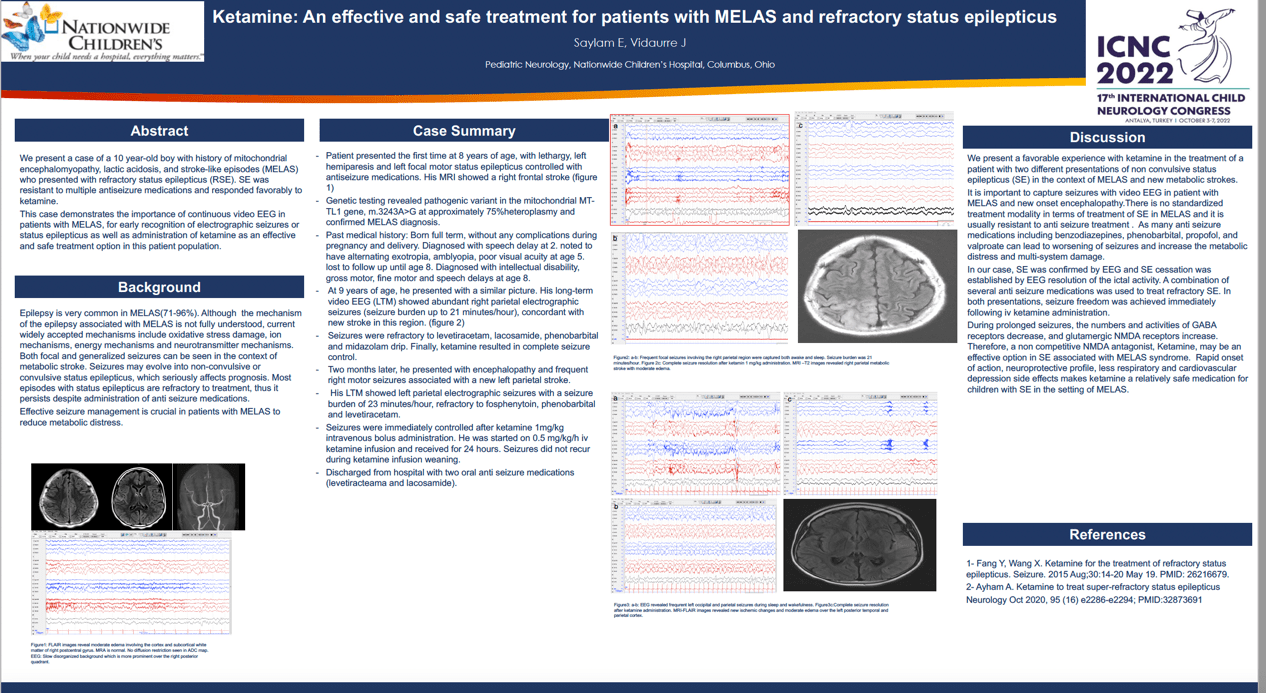Ketamine: An effective and safe treatment for patients with MELAS and refractory status epilepticus
Ezgi Saylam, Jorge Vidaurre
We present the case of a 10 -year-old boy with history of Mitochondrial encephalomyopathy, lactic acidosis, and stroke-like episodes (MELAS). He presented the first time at 8 years of age, with lethargy, left hemiparesis and left focal motor status epilepticus controlled with antiseizure medications. His MRI showed a right frontal stroke. At 9 years of age, he presented with a similar picture. His long-term video EEG (LTM) showed abundant right parietal electrographic seizures (seizure burden up to 21 minutes/hour), concordant with new stroke in this region. Seizures were refractory to levetiracetam, lacosamide, phenobarbital and midazolam drip. Finally, ketamine resulted in complete seizure control. Two months later, he presented with encephalopathy and frequent right motor seizures associated with a new left parietal stroke. His LTM showed left parietal electrographic seizures with a seizure burden of 23 minutes/hour, refractory to fosphenytoin, phenobarbital and levetiracetam. Again, seizures were quickly controlled with ketamine. This case demonstrates the importance of continuous video EEG in patients with MELAS, for early recognition of electrographic seizures or status epilepticus. These seizures can be of difficult control and refractory to broad spectrum medications, including GABAergic drugs and anesthetic agents. Ketamine a NMDA receptor antagonist appears effective and safe in treating refractory seizures in children with MELAS. Ketamine has become a more commonly used medication in the intensive care units and can be an excellent option in mitochondrial conditions, given the lack of cardiovascular and respiratory depression effect.
Keywords: MELAS, refractory status epilepticus, Ketamine, NMDA receptor antagonist
Ezgi Saylam
Nationwide Children's Hospital
United States
Jorge Vidaurre
Nationwide Children's Hospital
United States
We present the case of a 10 -year-old boy with history of Mitochondrial encephalomyopathy, lactic acidosis, and stroke-like episodes (MELAS). He presented the first time at 8 years of age, with lethargy, left hemiparesis and left focal motor status epilepticus controlled with antiseizure medications. His MRI showed a right frontal stroke. At 9 years of age, he presented with a similar picture. His long-term video EEG (LTM) showed abundant right parietal electrographic seizures (seizure burden up to 21 minutes/hour), concordant with new stroke in this region. Seizures were refractory to levetiracetam, lacosamide, phenobarbital and midazolam drip. Finally, ketamine resulted in complete seizure control. Two months later, he presented with encephalopathy and frequent right motor seizures associated with a new left parietal stroke. His LTM showed left parietal electrographic seizures with a seizure burden of 23 minutes/hour, refractory to fosphenytoin, phenobarbital and levetiracetam. Again, seizures were quickly controlled with ketamine. This case demonstrates the importance of continuous video EEG in patients with MELAS, for early recognition of electrographic seizures or status epilepticus. These seizures can be of difficult control and refractory to broad spectrum medications, including GABAergic drugs and anesthetic agents. Ketamine a NMDA receptor antagonist appears effective and safe in treating refractory seizures in children with MELAS. Ketamine has become a more commonly used medication in the intensive care units and can be an excellent option in mitochondrial conditions, given the lack of cardiovascular and respiratory depression effect.
Keywords: MELAS, refractory status epilepticus, Ketamine, NMDA receptor antagonist
Ezgi Saylam
Nationwide Children's Hospital
United States
Jorge Vidaurre
Nationwide Children's Hospital
United States

Jorge Vidaurre
Nationwide Children's Hospital
United States
Nationwide Children's Hospital
United States